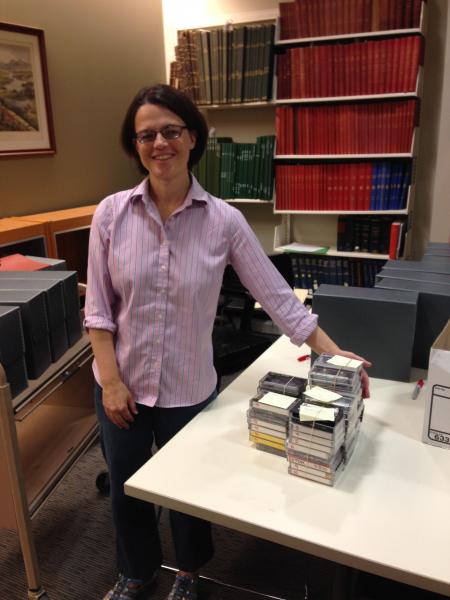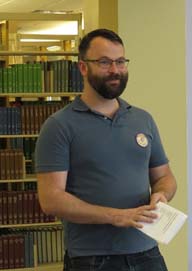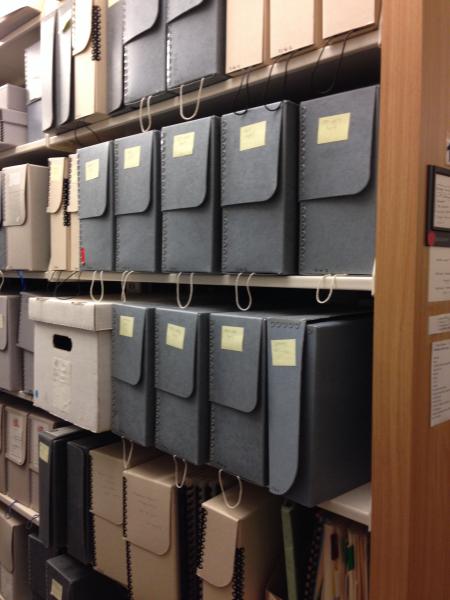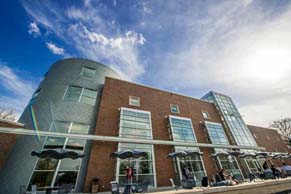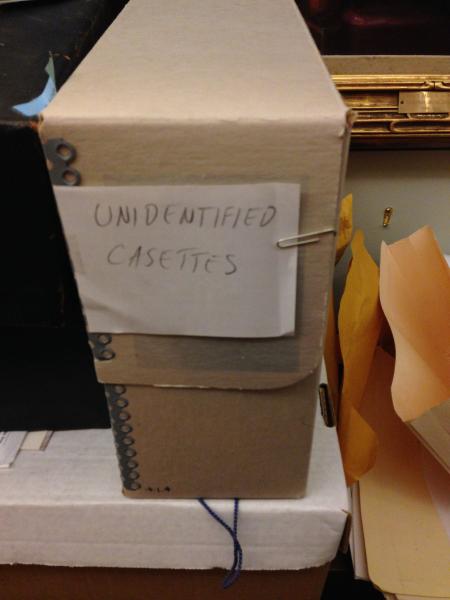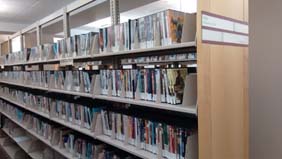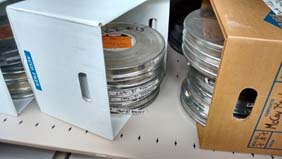A Year in the Life of Audiovisual/Media Preservation in Illinois: An Introduction
Miriam Centeno, University of Illinois at Urbana-Champaign
Have you ever had the experience of having a retired professor walk in to your library with an 8 mm film reel and not having the equipment to play it? Or has a donation come in for your archives with VHS tapes that are all covered in mold? How often do you worry about the state of your media collection? Have you ever tried to plan for its preservation?
Earlier this year, the CARLI Preservation Committee, as part of its Annual Project, conducted the 2015 CARLI Preservation Survey1. The purpose of the survey was to understand the level of institutional commitment to preservation and conservation of collections in all media/formats, and to assess preservation capabilities in the consortium. As a result of the 2015 CARLI Preservation Survey the committee decided to focus on the preservation of audio-visual (AV) materials for the upcoming year. Throughout this academic year we will follow two volunteer Illinois institutions, as they tackle the issues involved in the stewardship this type of cultural heritage.
Why Focus on The Preservation of AV Materials?
The survey provided the committee with a good understanding of the current state of library preservation and conservation among the CARLI governing members. The institutions acknowledge a greater need for preservation and conservation of their collections than they can meet. The survey results suggest that CARLI institutions need the most help in five areas:
- Disaster Planning
- Preservation Planning and Assessments
- Digital Preservation
- Preservation of Audio-Visual Materials
- Staff Training
The CARLI Preservation Committee looked at the past programming it served to the consortium. The programming had been successfully providing training and resources in most of these areas. However, the preservation of AV materials remained an underserved area for the consortium members.
Most of the expertise in the CARLI institutions is concentrated in the areas of book, paper and now increasingly digital preservation print materials. There is the growing sense that AV materials are at high risk and that the window for intervention is decreasing. As the FY2014 Preservation Statistics Survey Report asks:
- If audiovisual materials are more at-risk than paper-based formats, why is the continued focus of effort on digitizing paper-based formats, particularly unbound sheets (manuscripts, maps, posters, and works of art on paper)?
- Is reallocating resources from digitizing paper-based formats the most logical effective way to find resources to digitize audiovisual materials, or are there other activities that should be targeted for reduction in order to free up available resources?
- Further, when audiovisual materials are digitized, is effort focused on digitizing analog magnetic media over more at-risk audio-visual formats (lacquer discs, minidiscs, and digital audio tape)?
- How is the staffing area of AV Archivists, AV Conservators, and AV Preservation specialists growing? Will an increase in staffing in this area mark a recognizable uptick in the number and type of AV materials conserved and digitized in upcoming years?FY2014 Preservation Statistics Survey Report 2
Walking in Their Footsteps
This year-long project will shadow two professionals in two different institutions as they explore the following aspects of media preservation:
- Inventory
- Assessment/Care
- Reformatting /Digitization
- Disaster Planning
- Grant Writing
The two volunteers are Anne Thomason, from the Donnelley and Lee Library at Lake Forest College Library and Patrick Brown, from the Morris Library at the Southern Illinois University Carbondale. Recently Anne & Patrick met with Joshua Harris, Media Preservation Coordinator at University of Illinois Library at Urbana Champaign, to compare and contrast their different situations.
The most obvious differences is in their staffing & budget. While Patrick’s focus is on preservation, Anne has many other responsibilities in her job description, in which preserving the collection is not explicitly stated but definitely implied. She does not have a specific line item in her budget for preservation. They are both faced with the same situation in which their AV materials are spread throughout their facilities, housed in different collections, some of them are circulating, and mostly stored in climate conditions that are not optimal for their format. Patrick has some nitrate films safely stored in a freezer3. Anne is beginning to create an inventory of her AV materials. Patrick is analyzing the results of an assessment that was done prior to his arrival at SIUC.
Prioritizing what gets selected for preservation is another challenge. In both libraries, patron requests drive much of the reformatting activity. Increasingly digital copies are made for patron use, to spare the wear and tear on the original. When the library’s own physical copy does not yield a good digital product, copies from other institutions are sought. Both Anne & Patrick hope that this year’s project can help them plan for a more systematic approach to their reformatting work.
Finding Expert Advice
Their exploration into the preservation of audio-visual materials in heritage institutions could not be timelier. Joshua Harris empathized with much of what Anne & Patrick had to say about the state of their media collections. He had just presented on a similar topic at the ICA-SUV 2015 Conference in Chapel Hill, NC. 4 The theme for this year was Audiovisual Archives in Universities and Research Institutions.5 In his experience this was the first time that a conference focused specifically on the state of A/V preservation in academic settings.
For much of his career, Harris has seen Media Preservation treated as part of the business model calculations of large corporations, primarily broadcasting and entertainment companies, that see their media collections as commodities that they can monetize through online access and other platforms. Universities did not share the same economic concerns as part of their goals to provide access to research and enhance cultural heritage. For example, the usual charges collected by libraries and archives for the use of their art slide collection in publications, rarely recoup the cost of making them. Academic institutions have long worried about the complexity and the high cost of setting up a media preservation program and the difficulty in acquiring staff with the right expertise. The strategy has been a “let’s wait and see if it gets easier” waiting game.
Harris goes on to say that, just as is noted in the FY2014 Preservation Statistics Survey Report, media has taken a back seat intellectually to the written word. It is not until recently that academic researchers have accepted the use of film or audio materials as primary sources. “Now we can see in hindsight the flaw in that mindset.” Nonetheless, university archives have been wary of collecting media, worried about who would want to use these materials, how to take care of them, how difficult they are to use and how to provide for their continued access in the future.
Just as creating inventories of current holdings is a first step in understanding the preservation needs of a collection, so is the task of creating descriptions for uncatalogued items. Often library and archives accept gifts or donations where some media is part of the collection package. Since many of these items are not labeled and not easily accessible for playback, they are often put away unprocessed. This adds another layer of complexity to the challenge, as the importance of such items are unknown without some type of further examination and thus makes prioritization and allocation of resources difficult.
Looking at New Approaches to AV Preservation
There are few places in Illinois that have the facilities and expertise to provide such treatments. Based in Urbana-Champaign, Harris has found himself increasingly on demand for consulting advice all along the Midwest. An idea has emerged to create a regional AV preservation center lab that would provide services to libraries and universities statewide. This he said would develop slowly, starting with a pilot/ prototype project, and discussions could begin with CARLI and gradually increase as the UIUC preservation lab’s capabilities increased.
A similar statewide effort is underway with the California Preservation Program’s California Audiovisual Preservation Project (CAVPP). The CAVPP project and its resulting California Light and Sound Collection, aims to work via the Internet Archive (archive.org) for teaching, research, and study by partnering with libraries, museums, and archives.6 The intent is “to capture and make accessible audiovisual content in such a way that even libraries, museums, and archives with limited resources can participate.” The CAVPP claims that it has helped to streamline the preservation workflow by establishing and reviewing current standards and practices. 7
For academic institutions there is the closer example of the Media Digitization & Preservation Initiative (MDPI) at Indiana University (IU), Bloomington. The website states that as a result of a 2008 which found the much of its media archival research holdings was at risk and that they had a small window of opportunity to act.8 The initiative is “Indiana University's comprehensive work to preserve historical and cultural time-based media for the research, education, and enrichment of future generations.” 9
The MDPI’s programmatic structure has four phases:
- pre-digitization
- digitization
- preservation
- discovery and access
A Library of Congress report on sound preservation found that “The careful and thorough design and scope of the IU study might serve as a model for other institutions...”10 The MDPI initiative began conducting full scale digitization in May of 2015.
With the inability of many institutions to handle the media preservation challenge on their own, it is clear that both collection assessments and collaborative partnerships hold the possibility for wider swaths of the audiovisual record to be protected. It will likely be necessary for institutions with in-house facilities and expertise to take the lead in this regard. Such media preservation centers, like the MDPI and, can serve the dual role of taking care of their own collections as well as provide services to other institutions for a fee.
This is only the beginning for our two case studies institutions, and the CARLI Preservation Committee hopes this project will be of service to those contemplating media preservation and to the enhancement of preservation services to the heritage collections in the state of Illinois.
Illinois AV Preservation Case Studies Profiles
|
Institution Name |
Donnelley and Lee Library, Lake Forest College |
Morris Library, Southern Illinois University Carbondale |
|---|---|---|
|
Info on the “reporting agent” with a little bio, description of principal duties & preservation role |
Anne Thomason
Anne Thomason is the College Archivist and Librarian for Special Collection at Lake Forest College. Anne graduated from the University of Michigan School of Information in 2008 and has been at Lake Forest since February 2014. She previously worked at Earlham College in Indiana. The primary responsibilities of the position are to collect, organize, process, preserve, and provide access to the collection of institutional records, manuscripts and photographs. Additional responsibilities include management of the collections and promoting their use by our students, faculty, staff and other researchers through reference, instruction and outreach programs. The College does not have a preservation department and I believe I’m the only librarian with preservation as a significant part of my job description. However, access has been the top priority since I arrived. |
Patrick Brown
Patrick Brown is the Preservation Librarian at the Morris Library in Southern Illinois University Carbondale. Patrick Brown has a MSLS from UNC Chapel Hill School of Information and Library Science. His path into Preservation started as a student worker in in the Emory Libraries’ Preservation Department. Prior to starting at SIUC, he worked on the Iraqi Jewish Archive project at the National Archives. At the Morris Library, Patrick is responsible for preservation policy in the library and oversees the care of a variety of collections: from circulating general collections to the non-circulating archives, special collections & rare books. |
|
Type of Institution |
Small liberal arts college (1,600 undergraduate students) |
Southern Illinois University is a public research university (13,461 undergraduate and 4,500 graduate students) |
|
Description of overall collection |
The Lake Forest College Archives and Special Collections consist of the institutional records of the College and collections related to the history and architecture of Chicago and the City of Lake Forest. Significant collections include the Edward Bennett Papers, which includes Plan of Chicago correspondence between Daniel Burnham and Edward Bennett, drawings related to the Plan, and many photographs of Chicago and the architects; the Joseph Medill Patterson Papers that document Patterson's career as co-publisher and publisher of the Chicago Tribune, the New York Daily News, and Liberty magazine; and the Lake Effect Collection that contains resources relevant to the environmental, political, public health, and scientific issues surrounding Waukegan Harbor. Other collections include a variety of materials on the history of Lake Forest, including documents from the Lake Forest Association, and the blueprints for Market Square. There are also many smaller collections that include Chicago theatre programs, photographs, and railroad history. |
Morris Library is the main library for SIU Carbondale. It is an ARL member library. Its circulating collection includes than 3.2 million volumes, 200,000 e-books, 43,000 current periodicals and serials, and over 3.6 million microform units. Its Special Collection Research Center includes several units including University Archives, Manuscripts, Rare Books, Political Papers, Illinois Regional Archives Depository (IRAD), and Records Management.
|
|
General description AV collection |
|
AV materials are present in all of the collections. In the circulating collection, AV is primarily segregated in locations by media type (Music CDs, DVDs, and VHS.) In Special Collections, AV materials are found in the manuscripts collection, University Papers, Political Papers If AV Material is requested by the researcher, the condition of the item is evaluated and, if possible, digital access copy is more. Normally access is only given through digital surrogates. |
General Questions about the Case Studies’ AV Collections
| Question | Anne | Patrick |
|---|---|---|
|
Media is also scattered throughout the collections. The major challenge right now is the lack of an inventory to know what is where. Some of the equipment, like tape players, do not work. Since the AV material is located in different parts of the collections there is no dedicated storage space and no specific climate controlled area. |
In becoming acquainted with the collections he learned that an AV assessment had been done some three years prior to his start at SIUC. The assessment was made using the AVSAP online assessment tool.11 He found that it is hard to make sense of the results of an assessment when he was not there at the time that the assessment criteria was created. |
|
|
|
|
|
Still trying to learn that from the AVSAP assessment |
|
Anne found some of her cassette tape players did not work for a patron and had to find replacement. |
|
|
|
|
Resources
- CARLI Preservation Committee. "2014-2015 Preservation Committee Annual Project: Preservation Survey."
- Peterson, Annie, Holly Robertson, and Nick Szydlowski. "FY2014 Preservation Statistics Survey Reports."
- Association of Moving Image Archivists (AMIA). "Identifying and Handling Nitrate Film."
- Harris, Joshua. “The Current State of Media Preservation: Assessment as a Pathway to Meeting the Challenge.” Paper presented at the International Council on Archives Section on University and Research Institution Archives (ICA-SUV) , Audiovisual Archives in Universities and Research Institutions, July 2015, Chapel Hill, NC.
- International Council on Archives Section on University and Research Institution Archives (ICA-SUV). Audiovisual Archives in Universities and Research Institutions. 13-16 Jul. 2015.
- California Preservation Program. California Audiovisual Preservation Project (CAVPP).
- Hulser Richard P. "The California Light and Sound Collection: Preservation Our Media Heritage." Information Today Europe. April 2015.
- Indiana University. Media Digitization & Preservation Initiative Announcement.
- Indiana University. Media Digitization & Preservation Initiative.
- Council on Library and Information Resources and The Library of Congress. "The State of Recorded Sound Preservation in the United States: A National Legacy at Risk in the Digital Age."
- Audiovisual Self-Assessment Program (AvSAP).
- Preservation Self-Assessment Program (PSAP).


